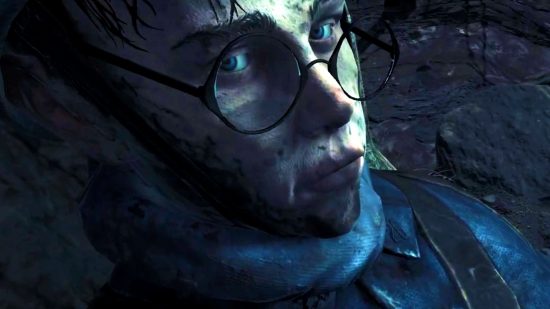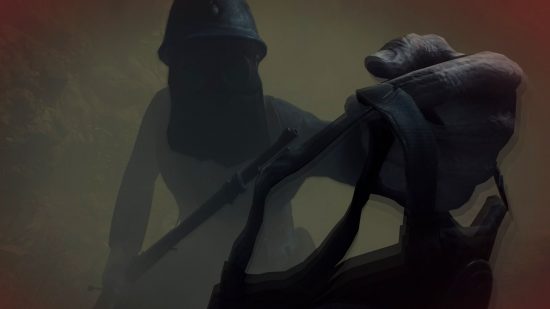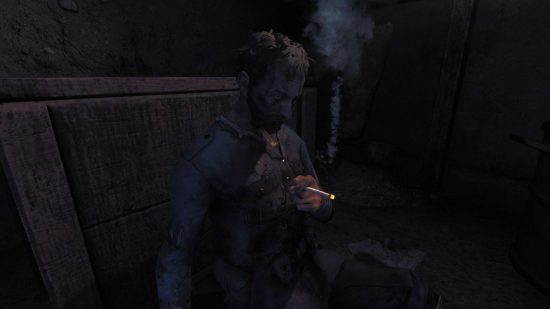Countless war games have tried to capture the essence of military conflict on a massive scale. Whether it’s from the bloodless perspective of a tactical commander overseeing the battlefield, or as a heartfelt tableau of valiant hearts lost in the trenches, videogames have grappled with the weight of its enormity across all genres. It’s notable that horror games set during the Great War are few and far between, drowned out by first-person shooters that have you charging along hedgerows brandishing a bolt-action rifle flush with ammo. Amnesia The Bunker bucks that trend, eschewing the grandiose to capture the sensory and emotional experience of the horror of trench warfare, echoing the prominent WWI poets that came before it.
To really do Amnesia The Bunker’s poetic horror justice, we need to delve into its various twists, as well as its ending – needless to say, there are spoilers below.
The Bunker opens with protagonist Henri Clement vaulting into a trench to escape a hail of enemy fire. Thus begins the game’s tutorial: scavenging for bullets for a spare standard-issue six-chambered revolver, ducking behind cover to avoid the sightlines of the German forces, and almost succumbing to a surprise gas attack. This frantic introduction delivers a distinct sense of place – the immediacy of the calamitous Great War unfolding around you – then abruptly traps you in the eponymous bunker.
This is the point at which long-time fans of the series might expect The Bunker to leave the war behind. Whether it’s the lavishly furnished rooms of Brennenburg Castle or the sun-bleached landscape of the Algerian desert, previous locations in the Amnesia series are imbued with a transitory, dreamlike state. As in a traditional Lovecraftian tale, their defined sense of place gradually falls away as the cthonic forces that drive each narrative take hold. While this supernatural displacement is incredibly unnerving, it also comes with the overarching sense that previous events in the series could take place in any castle, any desert, and still hold muster. The events of Amnesia The Bunker, however, could not take place anywhere else.
The bunker has no end to the parallels of the trenches that lie beyond its walls. Its corridors are oppressively narrow and typically present one of two directions: forward or back. Detritus, including sandbags, disused ammunition boxes, and dead bodies, litter its many rooms, and endless strings of electrical wire provide scant power to doors and lights. As I descend deeper into the bunker’s bowels, I encounter tripwires and snares that trigger grenades and gas, trench traps that were a common occurrence towards the end of WWI. In the split-second moment between setting off a gas grenade and pulling up the inventory to equip a gas mask. I can’t help but be reminded of the ‘ecstasy of fumbling’ as described by Wilfred Owen in Dulce et Decorum Est. This latest iteration of Amnesia even swaps its iconic, timeless lantern for a historically accurate, mechanically powered dynamo flashlight, and just the sound of its whirring pull cord is enough to draw the attention of the Stalker.
Naturally, Amnesia The Bunker is designed to put you in situations where you’re forced to draw the Stalker’s ire. This supernatural predator assumes a humanoid shape twisted into a bestial form. It’s also utterly inescapable, employing trench tactics to tunnel from area to area – including the bunker’s only safe room, much to my horror. Close encounters typically consist of a flurry of activity (an explosion, a gunshot, a brick thrown at a door to gain entry) and then a tense few moments as the Stalker descends and all you can do is hunker down and wait for it to pass, or attempt a suicide run. As a walking metaphor for the ‘war to end all wars,’ it’s certainly effective.
The quiet revelation that the Stalker is Augustin Lambert, Clement’s wide-eyed brother-in-arms, is consigned to lost notes and implication. His metamorphosis echoes Owen’s own vocalization of the grotesque effects of the indoctrination of war upon young men in Arms and the Boy, with the suggestion of claws, talons, and antlers, and the ‘cartridges of fine zinc teeth / Sharp with the sharpness of grief and death’. This juxtaposition between the war-touched soldier and the innocent child extends to the one clue that serves as confirmation: a toy rabbit, purchased by Lambert as a gift for his son. When I throw the toy in a last-ditch attempt to escape certain death, the Stalker ceases its rampaging to cradle it with care. Lambert retains a glimmer of humanity but is irrevocably changed, just as all soldiers of war.
Moreover, Lambert’s horrific transformation into the Stalker is in itself a nod to the soldiers who were forced to collect water from the bottom of shell holes, heedless of whatever diseases it might contain in the face of chronic dehydration. The water itself is administered by Henri from his waterskin, which Lambert drinks gratefully – this simple act of human compassion is lethal on the frontline, and echoes Siegfried Sassoon’s The Death Bed: ‘Someone was holding water to his mouth / He swallowed, unresisting; moaned and dropped / Through crimson gloom to darkness.’
While the Stalker is undoubtedly the greatest threat that you can encounter down in the dark, it’s also not alone. Henri is regularly beset by swarms of enormous rats that feast on corpses and discarded rations, often blocking the path to an objective. These vermin are an obvious counterpart to the infamous trench rats that proliferated in both size and number during WWI, and quickly became an inescapable torment to the soldiers that were forced to co-exist with them.
In the bunker, rats attack in large numbers when threatened, and doggedly follow the blood trails Henri leaves when injured. I’m continuously confronted with the obvious dilemma of how to dispatch them; I might opt to use my pistol, grenades, or a lit torch to either kill or dissuade them – but supplies are scarce, and for as many rats as I can kill, more will eventually take their place. Despite my frustration, I can’t help but feel a certain affinity with them as I slink from room to room in the bunker, opportunistic and desperate to survive. ‘Not worse than ours the lives rats lead,’ Owen says in A Terre, and as I descend upon another corpse to search for yet another code scrawled on the back of a dog tag, I can’t help but agree.
While there are no scripted sequences, it’s telling that the closest The Bunker ever comes to a jumpscare doesn’t actually involve the Stalker at all. Shell bombardments occur at random and rock the bunker to its very foundations, and their muffled ‘boom’ far surpasses the binaural scrabbling of the Stalker on the prowl. The Bunker’s soundscape is a constant callback to what lies beyond the confines of the bunker, but even this pales in comparison to my ascent into the bunker’s pillbox.
As I climb the ladder, I glance up to see a shaft of golden light beaming down from a crack in the pillbox roof. Perhaps naively, I begin to consider that this might constitute a way out; after all, The Bunker flirts with immersive sim design, a genre defined by possibility. Once inside, I’m met with a view that spans across all of no man’s land, a pastoral idyll of the French countryside. I’m struck by the resemblance to Constable’s landscapes, wreathed in smoke – until the bullets ricocheting off the pillbox break the spell, and I’m catapulted into Owen’s nightmarish astral projection in The Show, right down to the ‘horror of harsh wire’ that winds its way across the pillbox window. The war might be rampaging through the bunker, but it lies beyond it as well, spanning a country – a world.
The Bunker’s grim, poetic horror culminates in its final moments. Henri stumbles out of the tunnels and into the light of no man’s land and slips into a shell crater awash with the decaying and dismembered corpses of his fellow soldiers. As he examines their remains, it becomes glaringly apparent that there’s nothing materially different about these bodies and those within the bunker. The fatal wounds inflicted by the Stalker are an exact mirror to the fallen soldiers in no man’s land – their torn uniform, missing limbs, and disfigured faces are wholly analogous to one another.
In his flight from the bunker and the Stalker within, Henri has been driven ‘over the top’. There is nowhere to turn, nowhere to run. As German soldiers close in on his position, the Great War stalks along with them, and the hard cut to black spells the finality, the futility of his struggle to escape. Henri becomes Lambert’s stuffed rabbit, ‘lying in that crater, rain and weather matting its fur, unloved, forgotten, totally alone, lost forever.’ In an echo of Owen, Henri’s end is far from sweet – and yet, in the context of the poets that sought to capture the fear, horror, and futility of WWI, it is entirely fitting.






